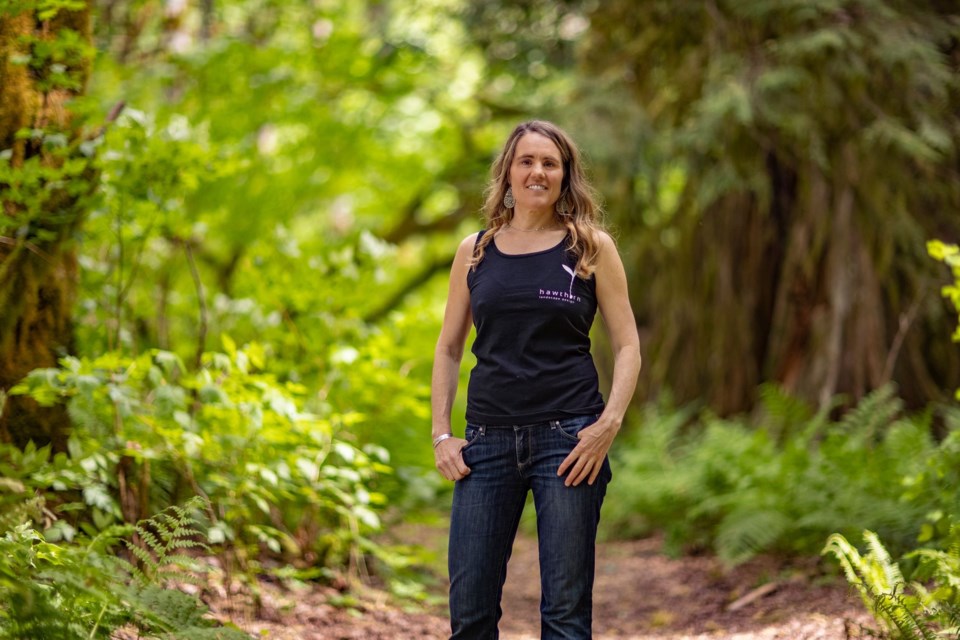Planting a tree in your yard is like making an investment in the future of your environment.
If a Sea to Sky landscaper takes the time to purchase a young native sapling and find it an appropriate spot to live long-term on their property, they’re making an instant impact on that baby tree’s surrounding ecosystem. It literally purifies the air around it, providing shade aesthetic beauty and countless other benefits.
The older it gets, the more it gives back.
Ultimately the tree will probably outlive its human parent, providing multiple generations with its reassuringly permanent presence—a looming bulwark against the effects of climate change, just one way that Sea to Sky gardeners can demonstrate their climate-conscious ideals.
Unpaving the planet
Sometimes, making a climate-conscious decision about your property is as simple as planting that tree, and sometimes the problem is more complex. Maybe you need to explore alternatives to the two-stroke engine powering your lawn equipment or installing a low-drip faucet for your flowers. Or maybe you need to switch out your fertilizer for something more earth-friendly.
Whatever the particular issue, more and more gardening enthusiasts in the Sea to Sky region are seeking creative solutions to lessen their impact on the environment. This is where mentors like Squamish ecological design expert Kathryn Weiler come in.
“We’re trying to unpave the planet one garden at a time. In this area, people are very enthusiastic about their greenspaces and are becoming even more so. Lawns are important, because most people have them, and now we’re seeing more lawn alternatives becoming more popular. People are using more organic products, and getting enthusiastic about native plants and pollinators,” Weiler told The Squamish Chief.
And though she advocates for planting as many trees as possible, she encourages homeowners to try to incorporate species that are native to the area. Because of how the changing climate has disrupted plant growth and the health of the ecosystem, it’s strategic to plant a diverse variety of trees in case they’re negatively impacted in the future.
“Gone are the days when we all plant the same cherry tree, or elm tree, because along comes one bug or one change in the weather—maybe it’s an unusually hot summer or a harsh winter—and who knows which ones will survive? There’s no silver bullet for what you should plant, but native species tend to be the most resilient.”
Notice the natural world
Weiler is the founder of Hawthorn Landscape Design, which has been working for over a decade to introduce more environmentally-friendly green spaces and sustainable gardening practices to the Sea to Sky Corridor. Sometimes that can feel like an uphill battle. But it comes down to something really simple: paying careful attention to your environment.
“Noticing plants and noticing the natural world can be really helpful in terms of understanding what you want in the garden, what matters to you,” said Weiler.
“It’s about being present.”
According to Weiler, many families still want the iconic lime green lawn that they fertilize every day, and gentle education isn’t enough to convince them that it’s wasteful or destructive to the environment.
She champions alternatives like bee turf and micro clover for lawn renovation, which can effectively transform a yard from having a wasteful mono-crop to a lush and beautiful natural environment for insects and animals.
“It’s something you can be excited about that’s not hard to accomplish. You just let a patch of grass grow a bit longer, and suddenly, you have pollinators. I call it ‘create your own meadow,’” she said.
Most people are uninformed about the importance of pollinators, according to Weiler, who believes they are a crucial aspect of understanding the climate puzzle. Some cities have built “pollinator highways” with beds of lavender and other plants to encourage their migration, which is the sort of innovation she’d like to see in Squamish as well.
“It’s not just about bees. There are tons of insects and other pollinators that benefit from having access to native plants. There are pollinator species that only go to their native plant, won’t go to any flower in the nursery, they need that specific one,” she said.
“Choosing to plant’s native species is something simple you can do that will have a huge impact.”
‘We all have to be conscious’
Weiler feels that gardeners have all the tools available to them to be climate-conscious, but awareness is low and budget constraints often get in the way. Simple changes like switching to low-drip irrigation or growing vegetables can put homeowners on the path to sustainability.
“Green infrastructure like gardens, plants, it’s a resource that keeps giving back over time and now a lot of cities are focusing more on green infrastructure to mitigate climate change. It’s really encouraging to see,” she said.
“When I think about climate change, there is despair. I have my own personal feelings about it. One small way you can control your environment is through your garden. Having a wide variety of plants, shrubs, trees and perennial flowers is a smart move, because we don’t know what the next several decades will bring in terms of weather. We all have to be conscious.”
Editor's note: This story was part of a special Home & Garden sales feature in The Squamish Chief print edition on May 23. The story was written independently of the sales department and the business mentioned.



